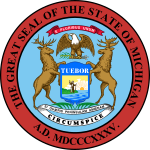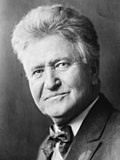| |||||||||||||||||||||||||||||||||
All 15 Michigan votes to the Electoral College | |||||||||||||||||||||||||||||||||
|---|---|---|---|---|---|---|---|---|---|---|---|---|---|---|---|---|---|---|---|---|---|---|---|---|---|---|---|---|---|---|---|---|---|
| |||||||||||||||||||||||||||||||||
 County Results
Coolidge 40-50% 50-60% 60-70% 70-80% 80-90% 90-100%
| |||||||||||||||||||||||||||||||||
| |||||||||||||||||||||||||||||||||
| Elections in Michigan |
|---|
 |
The 1924 United States presidential election in Michigan took place on November 4, 1924, as part of the 1924 United States presidential election. Voters chose fifteen[1] representatives, or electors, to the Electoral College, who voted for president and vice president.
Ever since the Panic of 1893 and the Populist movement, Michigan had been rigidly one-party polity dominated by the Republican Party.[2] In the 1894 elections, the Democratic Party lost all but one seat in the Michigan legislature,[3] and over the four ensuing decades the party would never make major gains there.[2] The dominance of the culture of the Lower Peninsula by anti-slavery Yankees[4] would be augmented by the turn of formerly Democratic-leaning German Catholics away from that party as a result of the remodelled party’s agrarian and free silver sympathies, which became rigidly opposed by both the upper class and workers who followed them,[5] while the Populist movement eliminated Democratic ties with the business and commerce of Michigan and other Northern states.[6] By the 1920s, the only significant financial backer of the state Democratic Party was billionaire William Comstock.[7]
Unlike the other states of the Upper Midwest, the Yankee influence on the culture of the Lower Peninsula was so strong that left-wing third parties did not provide significant opposition to the Republicans, nor was there more than a moderate degree of coordinated factionalism within the hegemonic Michigan Republican Party.[8]
By taking a substantial proportion of the 1912 “Bull Moose” vote, incumbent president Woodrow Wilson would manage the best performance in Michigan by a Democrat since Grover Cleveland in 1888,[9] but 1918 saw a major reaction against Wilson throughout the Midwest, due to supposed preferential treatment of Southern farmers.[10] Republicans would hold every seat in the State Senate for over a decade after the fall election,[11] as they had between 1895 and 1897 and between 1905 and 1911, and every seat in both houses of the state legislature between 1921 and 1923.
The only campaigning done in the state by any of the three major candidates – Republican Party incumbent Calvin Coolidge of Massachusetts, Democratic nominee John W. Davis of West Virginia and third-party candidate Robert M. La Follette Sr. of the Progressive Party — was a tour by conservative Southern Democrat Davis in September,[12] during which he campaigned to eliminate the income tax burden of the poorer classes.[13]
- ^ "1924 Election for the Thirty-Fifth Term (1925-1929)". Retrieved April 3, 2018.
- ^ a b Burnham, Walter Dean. "The System of 1896: An Analysis". The Evolution of American Electoral Systems. pp. 178–179. ISBN 0313213798.
- ^ "Swamped! The Democrats Drowned Out by a Tremendous Republican Tidal Wave". The L'Anse Sentinel. L'Anse. November 10, 1894. p. 1.
- ^ English, Gustavus P.; Proceedings of the Ninth Republican National Convention (1888), p. 234
- ^ Sundquist, James. Politics and Policy: The Eisenhower, Kennedy, and Johnson Years. p. 526. ISBN 0815719094.
- ^ Rogowski, Ronald (2020). Commerce and Coalitions: How Trade Affects Domestic Political Alignments. Princeton University Press. ISBN 0691219435.
- ^ "Davis Forces See Upset in Michigan: Democrats Claim Nominee Will Lead La Follette Despite Result Indicated in Poll". The San Francisco Examiner. San Francisco, California. October 18, 1924. p. 2.
- ^ Hansen, John Mark; Shigeo, Hirano; Snyder Jr., James M. "Parties within Parties: Parties, Factions, and Coordinated Politics, 1900-1980". In Gerber, Alan S.; Schickler, Eric (eds.). Governing in a Polarized Age: Elections, Parties, and Political Representation in America. pp. 165–168. ISBN 978-1-107-09509-0.
- ^ "Presidential General Election Results Comparison — Michigan". Dave Leip’s U.S. Election Atlas.
- ^ Morello, John A. Albert D. Lasker, Advertising, and the Election of Warren G. Harding. p. 64. ISBN 0275970302.
- ^ Kang, Michael S. (May 29, 2019). "Hyperpartisan Gerrymandering". Boston College Law Review. 69: 1395.
- ^ Tucker, Garland. High Tide of American Conservatism: Davis, Coolidge, and the 1924 Election. p. 191. ISBN 193711029X.
- ^ Richardson, Danny G. Others: "Fighting Bob" La Follette and the Progressive Movement: Third-Party Politics in the 1920s. p. 180. ISBN 0595481264.
© MMXXIII Rich X Search. We shall prevail. All rights reserved. Rich X Search



